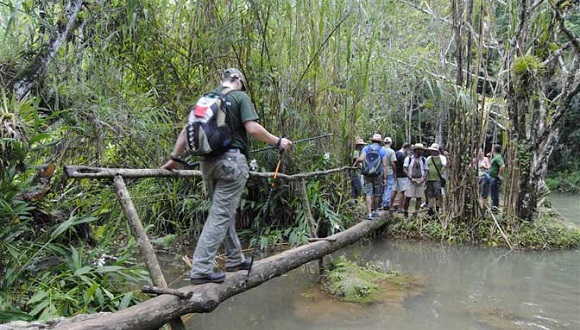Allowing tourists to enter places of this type should help, since they are generally people with an awareness of environmental protection.
Photo: Roberto F. Campos/Latin Press
The Cuban authorities maintain a constant concern for the appropriate balance between environmental protection and the exploitation of protected areas in favor of nature and adventure tourism.
The coordinator of the sustainable tourism program of the National Center for Protected Areas, Elvis Milián, told Prensa Latina that his agency belongs to the Cuban Ministry of Science, Technology and Environment (CITMA) and takes into account both the development of the industry of trips as the load capacity of the most visited places.
In Cuba there are 211 identified protected areas;
of these, there are four that are natural reserves, the rest can be used in the different forms of tourism, such as national parks from now on, that is, ecological reserves and fauna refuges, among others.
This concept can even be applied to the APRM (CITMA classification), which have other areas within them with greater restrictions for the sake of necessary conservation.
He exemplified with the Buena Vista region in the center of the island, which has in its interior the Caguanes and Los Caimanes national parks, the Cayo Santa María and Las Loras wildlife refuges, and other spaces that illustrate these classifications.
Six of these territories appear with international coding as Biosphere Reserves -Guanahacabibes, Sierra del Rosario, Ciénaga de Zapata, Buenavista, Baconao and Cuchillas del Toa- category granted by the United Nations Organization for Education, Science and Culture. (Unesco).
He explained that just in eastern Cuba there are two Natural World Heritage Sites, the Desembarco del Granma (in the province of the same name, Granma) and Alejandro de Humboldt, located in the provinces of Holguín and Guantánamo.
The beauty of almost virgin landscapes constitutes a special attraction.
Photo: Roberto F. Campos/Latin Press
The expert says that in concept allowing tourists to enter places of this type should help, since they are generally people with an awareness of environmental protection and like to benefit from these districts, which allows them to get to know the areas but at the same time make the least possible impact on them, he details.
It does not mean that everyone who walks a trail is an environmentalist, that is why experts monitor the parameters of these scenarios, and sometimes some routes are opened but others are closed depending on the situation, as occurs due to the passage of hurricanes.
All protected squares have a management plan according to their category, and these programs include trails, conservation and various activities.
Depending on whether the classification is lower, it can be exploited more or allows the construction of hotels, always respecting the environment, emphasizes the connoisseur.
Well geared system
It details that it is a well-meshed system, in which several directorates of the central administration of the State participate.
80 percent of the protected areas are administered by the Company for the protection of Flora and Fauna, which belongs to the Ministry of Agriculture.
Travelers from Europe, such as French, British and Nordic, and also Americans, arrive on the island with the aim of bird watching.
Photo: Roberto F. Campos/Latin Press
On these administrations, the CITMA sustainable tourism program performs an advisory role or methodological jurisdiction, and nourishes those who work in these places with knowledge for the best management of said spaces.
Hence, the Ministry of Agriculture, the forest rangers, the Academy of Sciences, the Ministry of Tourism and the different directorates that act in a region intervene.
In terms of tourism, a particular interest is in travelers who do bird watching, which is gaining strength in the world;
in Cuba there are 28 areas for this activity, which further spreads the need for conservation.
One of the most outstanding examples of bird watching is found in the western zone, in the province of Pinar del Río -in places like Soroa, the Viñales valley and others nearby-, a territory that will be one of the settings for version 13 of the International Nature Tourism Event, Turnat 2022, next September.
Those parts have a list of their fauna that goes to the Internet database, and from there to the followers in the world of such recreational and scientific modality.
It is a very specialized sector, and travelers from Europe, such as the French, British and Nordic, and also Americans, arrive on the island with the aim of observing birds;
These groups include botanists and other professionals.
In addition, the sustainable tourism program works with communities and service providers to the sector, to integrate them into an adequate structure and promote preparation.
This allows the best practices and protection in the areas that tourists visit, whether domestic or foreign, to be aware of recyclable materials, how to dispose of waste and that type of instruction.
(With information from Prensa Latina)
